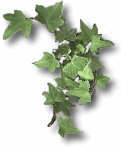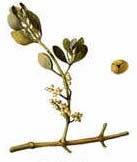|
|
| | | Mandrake and White Bryony | Mandrake ( Atropa mandragora ) The Mandrake is one of the most well-known of the magickal plants associated with Witchcraft. Mandrake root was used in ancient times to induce trance states. It is native to southern Europe and was first cultivated in England in 1562 by Turner, the author of the Niewe Herball. English Mandrake ( Bryonia dioica ) is a plant commonly known as White Bryony ( also poisonus ) and is a different species than the actual Mandrake. In England the roots of the Bryony plant were often sold as authentic Mandrake roots. English Herbalists clearly knew of Mandrake from old herbal texts as it featured among their writings. Whether true Mandrake was imported or whether White Bryony was substituted for actual use or even confused with actual Mandrake is unclear. In Italy small puppets made from Bryony root were very popular charms. The root of the Mandrake is large and woody and often resembles a puppet suggestive of human form. It is because of this human form that the Mandrake became viewed as such a magickal plant. The brown root is up to 3 or 4 feet long and are thought to come in both Male and Female forms. The leaves are large, dark green and have a distinctive and unpleasant smell, Its flowers are white and has apple-sized yellow fruit. The Mandrake fruit is also known as Satan's Apple. It was said that the Mandrake plant grew under gallows and it was thought that when it was pulled from the ground, it screamed and this scream if heard could drive a person mad or even kill them. It is also associated with Mercury, Uranus and Pluto. The Mandrake is a chthonic plant, believed to have power over creatures of darkness. Mixed with periwinkle, Mandrake often appears in incense as an aid to exorcism. It was placed on fireplace mantels to avert misfortune. This connects the Mandrake with the hearth and in turn with ancestral spirits such as the Lare ( see Faery Folk ). The Lare are protectors of home and family, therefore the offering of Mandrake on the mantel makes sense as an aversion of bad luck. The root has also been used to treat rheumatism and the fruit was used to induce sleep and even used as an anaesthetic, the leaves were made into poultices to treat ulcers. Mandrake was also hung over the bed to induce sleep, attract love and prevent nightmares and used in money and fertility spells, it was also thought of as protective, brought good luck and had the power to expel demons and counter curses. |
| | 
| Ivy The Ivy is a symbol of true love and friendship due to its nature, that it clings to anything it encounters with. The ancients believed that wearing a circle of Ivy around the head would prevent intoxication and that drinking from a bowl made of Ivy Wood would cure drunkeness. Ivy is also a tree of warning, dreaming of having visions of it may indicate that you are taking the wrong direction in life. The Roman God Bacchus wore a wreath of Ivy leaves and the thyrsus ( ancient Ritual Wand ) carried by Dionysos was entwined with Grape vines and Ivy. | | Mistletoe The Mistletoe is a symbol of immortality, love and liberation. Mistletoe growing on Oak trees was highly regarded as a Sacred plant by the Romans, Celts and Druids and was cut down with a gold or silver sickle with a single stroke, without letting it fall to the ground, if this did happen it was seen as a omen to a great disaster to the land. The juice of its berries resemble semen so it was thought to be the sperm of the Oak tree god and of great power. It was gathered and used to welcome in the New year and this custom is still around today when it is added to our Yule decorations. In magick Mistletoe is used in spells for protection, hunting, fertility, healing and exorcism. It is carried to ensure fertility and this is probably where the custom of kissing under the Mistletoe comes from. Burning Mistletoe drives out negativity and can break negative spells and hanging it around the house will protect against spirits. In Norse mythology it was the plant which was used to kill Balder and was said to grow on a branch of a sacred Oak at Lake Nemi where it was protected by The Gaurdian Of The Grove or Rex Nemorensis, King Of The Woods. |

|

...For Safe Herbs | | page by witching puppy |
|
|
 Free Forum Hosting
Free Forum Hosting